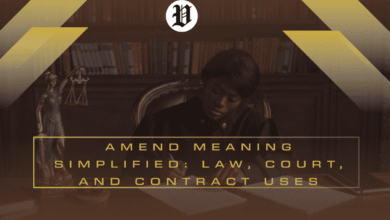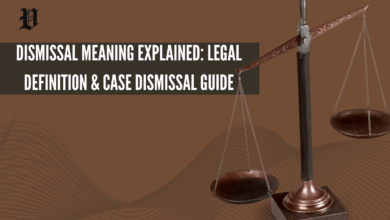Default Judgment: How to Set Aside or Vacate a Judgment Against You

Imagine this: you’re going about your day when you get a letter saying there’s a default judgment against you. Your stomach drops, and you’re thinking, “How do I fight a judgment against me?” If this sounds familiar, don’t panic—you’re not alone, and there are ways to tackle this. A default judgment can feel like a brick wall, but it’s not the end of the road. In this article, we’re going to walk you through what a default judgment is, how it messes with your life, and, most importantly, how you can push back by setting aside or vacating it.
I’ll dive into things like filing a motion to set aside default judgment, whether you can appeal a default judgment, and some state-specific tips to keep in mind. This isn’t legal advice—it’s more like a friend explaining the basics to get you started. For the nitty-gritty, you’ll want to talk to a lawyer.
Introduction to Default Judgment
So, what’s a default judgment? It’s when a court sides with the plaintiff—the person suing you—because you didn’t respond to the lawsuit or show up in court. Usually, you get a summons and complaint, and you’ve got a window, often 20-30 days, to reply. Miss that deadline, and the court hands the plaintiff a win by default, no trial needed. It’s like losing a game because you didn’t show up to play.
Why does this happen? Life gets messy. Maybe you never got the court papers (bad service), or you were dealing with a crisis—sick kid, job loss, or just buried under a pile of mail. Whatever the reason, the fallout can hit hard. A default judgment can tank your credit score, making it tough to rent a place, finance a car, or get a loan.
Worse, it opens the door to default judgment collections—think wage garnishment, where they take a chunk of your paycheck, or bank account seizures, where your savings get frozen or drained. It’s stressful, and it can even lead to liens on your property. That’s why knowing your options, like filing a motion to vacate default judgment, is a game-changer—it could give you a shot to fight back.
People also see: Free Consultation Lawyers in Las Vegas: Affordable Legal Help Guide
What Happens After a Default Judgment Is Issued?
Once that judgment lands, things can move fast. The plaintiff can start collecting what you owe, plus interest and fees. This might mean wage garnishment (up to 25% of your pay in many cases), a levy on your bank account, or even seizing stuff like your car or home equity. Default judgment collections are no joke—creditors don’t mess around. But don’t lose hope. You’ve got moves to make, like filing a motion to set aside or a motion to vacate default judgment, which can hit pause on collections while the court takes a second look. In some places, you might also work out a payment plan or, in extreme cases, consider bankruptcy to stop the bleeding.
Here’s a quick look at the process:
| Step | Action | Timeframe | Possible Outcome |
|---|---|---|---|
| 1. Default Judgment Entered | Judgment issued due to defendant’s failure to respond. | 30 days or less | Plaintiff wins by default. |
| 2. Motion to Set Aside Filed | Filing a motion to set aside the judgment. | 30 to 60 days | Court reviews the motion and determines if judgment should be vacated. |
| 3. Judgment Vacated | Judgment is reversed and case proceeds. | Varies | Court may reinstate the case, allowing for a defense. |
This is a rough guide—states have different timelines, so check your local court rules.
How to Set Aside or Vacate a Default Judgment
Wondering, “Can a default judgment be reversed?” Good news: it often can be, but you’ve got to act fast. Setting aside a default judgment or vacating it means asking the court to undo the judgment. You do this by filing a motion—either a motion to set aside default judgment or a motion to vacate default judgment. You’ll need to explain why you didn’t respond (say, you never got the papers) and show you’ve got a solid defense to the original claim.
Here’s how it usually goes: you write up your motion, include a sworn statement (called an affidavit) laying out your reasons, file it with the court, and send a copy to the plaintiff. Then, you show up at a hearing where a judge decides if you get a do-over. Common grounds for setting aside judgment include excusable neglect (like missing the deadline because of a family emergency), lack of proper service (you weren’t properly notified), mistake, or fraud. Lots of folks try this if they didn’t know about the lawsuit or if the court messed up the process.
Word to the wise: back up your story with evidence—think proof you weren’t served or doctor’s notes for an emergency. And don’t sleep on it—most states give you a tight window, like 6 months, to file.
How to Appeal a Default Judgment
So, can you appeal a default judgment? Yup, in many cases, but it’s not always the best first move. An appeal is about arguing the court made a legal mistake, not rehashing the whole case. You’d file a notice of appeal, usually within 30 days of the judgment. The court will look at things like whether you were properly served or if your due process rights were violated when deciding if a default judgment can be reversed.
Here’s the catch: an appeal might not stop collections right away, unlike a motion for relief from judgment. That’s why it’s often smarter to try vacating the judgment first with a motion to set aside, then appeal if that gets shot down. Check your state’s rules for the exact steps.
Legal Grounds for Setting Aside a Judgment
Let’s get into the nitty-gritty of grounds for setting aside judgment. Courts don’t just undo judgments for fun—you need a good reason. Federal rules, like FRCP 60, list things like mistake, excusable neglect, newly discovered evidence, fraud, or a void judgment (say, if the court didn’t have jurisdiction). FRCP 55 deals with entering defaults, but FRCP 60 is your go-to for undoing them.
States have similar rules. Take California’s CCP 473.5—it lets you set aside a judgment if you didn’t get actual notice, as long as you act fast (within 2 years, but don’t dawdle). Excusable neglect might cover missing a deadline because of a crisis, but not just blowing it off. Courts look at whether you moved quickly, if the plaintiff would be unfairly hurt, and if you’ve got a decent defense. A motion for relief from judgment under these rules can reopen your case if the judge agrees.
People also see: Breaking a Lease Due to Domestic Violence or Harassment: A Legal Guide
Jurisdiction-Specific Information
The process for dealing with a motion for default judgment or setting one aside isn’t the same everywhere—it depends on where you are. Timelines are make-or-break, so don’t miss them. In California, CCP 473 gives you up to 180 days for some grounds, but longer for void judgments. Texas’s Rule 329b says you’ve got 30 days for a new trial motion. Florida’s Rule 1.540 gives you up to a year for things like fraud or mistakes. In Nevada, including Las Vegas, NRCP 60(b) gives you 6 months for excusable neglect.
Here’s a quick breakdown:
| State | Motion Process | Relevant Code | Common Grounds for Setting Aside Judgment |
|---|---|---|---|
| California | Motion to Set Aside Default Judgment | CCP 473.5 | Excusable neglect, improper service, mistake |
| Texas | Motion to Set Aside Default Judgment | Texas Rule 329b | No notice, denial of due process, mistaken judgment |
| Florida | Motion to Vacate Default Judgment | Florida Rule 1.540 | Fraud, newly discovered evidence |
| Nevada | Motion to Set Aside Default Judgment | Nevada Rule 60(b) | Lack of notice, mistake, newly discovered evidence |
Las Vegas follows Nevada’s rules. Double-check with your local court for forms and fees—they’re different everywhere.
Frequently Asked Questions (FAQs)
What is a Default Judgment?
It’s when a court rules against you because you didn’t respond to a lawsuit, handing the plaintiff an automatic win.
Can I Appeal a Default Judgment?
Yes, usually within 30 days, but you’re arguing legal errors, like bad service. Try setting aside first.
How Do I Set Aside a Default Judgment?
File a motion explaining why you missed the deadline (like excusable neglect) and show you’ve got a defense. Then show up to a hearing.
What Are the Grounds for Setting Aside a Default Judgment?
Things like excusable neglect, improper service, fraud, mistakes, or new evidence.
How Long Do I Have to File a Motion to Set Aside a Default Judgment?
Depends—often 6 months for neglect, up to 2 years for no notice. Move fast.
Can a Default Judgment Be Reversed?
Yup, by vacating it or appealing, if you’ve got the right grounds.
What Happens After a Judgment is Set Aside?
The case reopens, giving you a chance to defend it, which could lead to a dismissal or settlement.
Can You Fight a Default Judgment in Court?
Absolutely—file a motion and make your case at a hearing.
In the end
A default judgment can feel like the world’s caving in, but it’s not a done deal. Whether it’s filing a motion to set aside, a motion to vacate default judgment, or even appealing, you’ve got ways to fight back. Can a default judgment be reversed? Often, yes, if you’ve got a good reason and don’t sit on your hands. The key is to act—ignoring it only makes things worse. Get a lawyer in your corner to help with stuff like a motion for relief from judgment. You’re tougher than this judgment, and knowing your options is the first step to getting back on track.





One Comment